Anyone can sell books on Amazon Kindle Direct Publishing (KDP). Opening an Amazon KDP account, listing, and selling books on Amazon are all free—and you get paid each time a book sells. We’ll walk you through setting up an Amazon KDP account and show you how to sell books on Amazon in four simple steps.
How Amazon Kindle Direct Publishing (KDP) Works
Amazon Kindle Direct Publishing is a free platform that lets independent authors sell both e-books and print-on-demand books on Amazon. It costs nothing to join KDP and sell e-books on Amazon, and you’re paid a royalty, ranging from 35 to 70 percent of your book’s price, every time it sells.
As a KDP author, you can sell on Amazon as well as marketplaces like Smashwords. Or, you can enroll some or all of your titles in Amazon’s exclusive sales program, called KDP Select. KDP Select titles can only be sold through Amazon, but in exchange for exclusivity, they qualify for added promotions, including:
- Listings in Kindle Unlimited (KU) – Amazon’s very popular subscription reading program pays authors per-read rather than per sale.
- Listings in Kindle Owners’ Lending Library (KOLL) – Gives every Kindle owner access to your title, and like KU, you’re paid on a per-borrow basis.
- Inclusion in KDP Select Promotions – Limited-time free pricing and special pricing countdown deals help attract readers and quickly grow your book reviews.
KDP authors can choose to list all, none, or just certain titles in KDP Select, so you’re always in control of where and how your books are sold through Amazon. Now we’ll show you how to get started with KDP and start selling e-books on Amazon, all in four easy steps.
1. Sign Up for Your Free Amazon Kindle Direct Publishing (KDP) Account
You can open your Amazon KDP account whether you have a book ready to sell or not. In fact, it’s a good idea to open your Amazon KDP account even before you have a book ready so you can access KDP’s many helpful tools and publishing tutorials. This way, when you book is complete, your account is already in place.
To set up your Kindle Direct Publishing account, go to kdp.amazon.com, and you’ll see this screen:
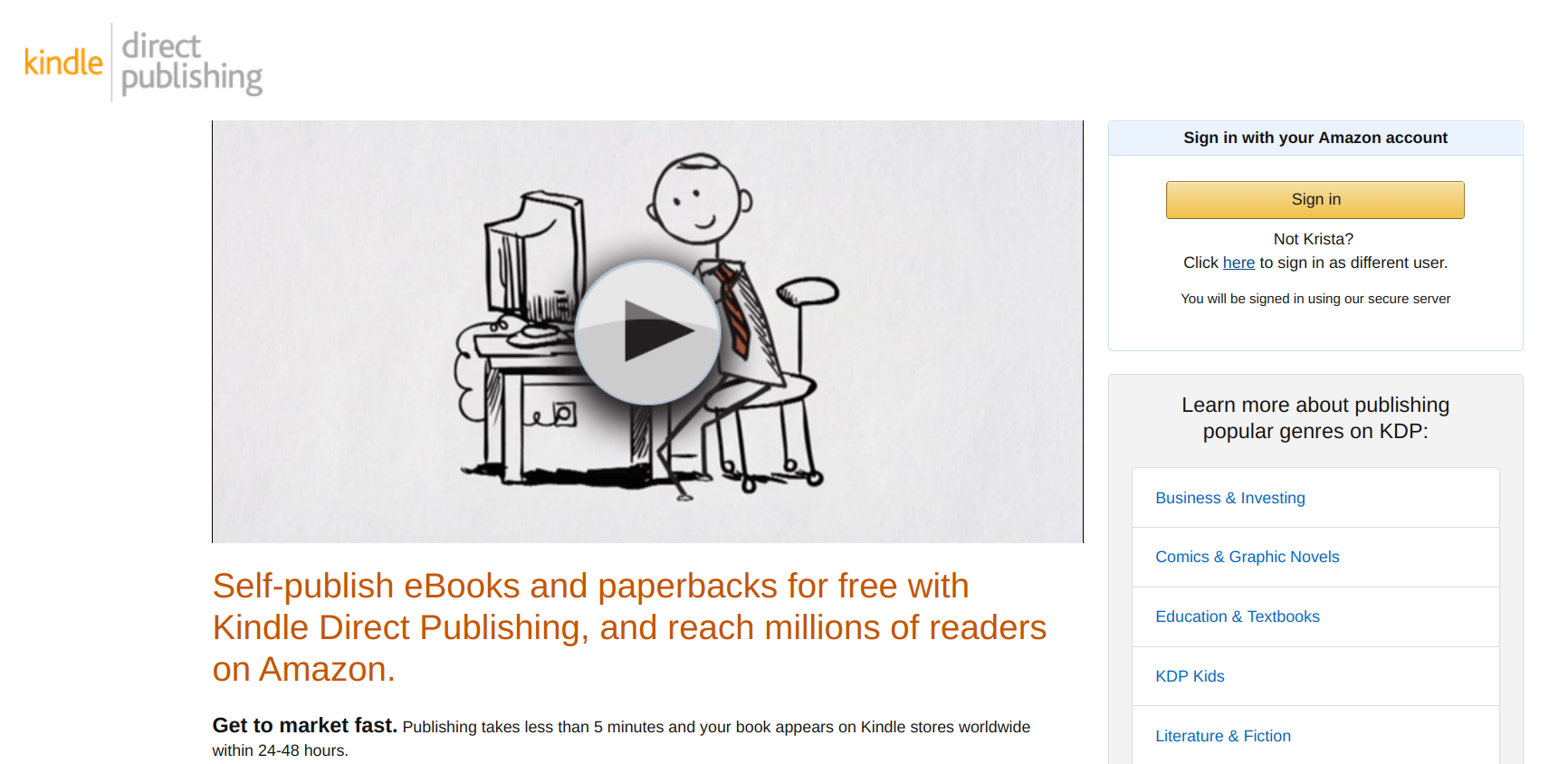
The KDP sign-in screen runs you through the basic up-front in a short video.
As you can see on the yellow Sign-in button, you need an Amazon account to create a KDP account. It’s important to note that Amazon seriously frowns on individuals having more than one Amazon account. But, according to Dave Chesson of Kindlepreneur, “Authors can open a separate account under a business entity, and this a good way to separate your book sales from your personal Amazon account.”
“Writers or business professionals with a business entity with its own tax number and bank account can sell books on Kindle Direct Publishing without having withholding taken out of royalty payments,” says Chesson. “Of course, royalty earnings must be included on business taxes, and Amazon provides the proper tax form for that. For professional authors or those selling books on Amazon for business purposes, it’s smart to handle it in a separate Amazon business account.”
Once you’ve decided how to proceed—as an individual or business—you’re ready to create your Kindle Direct Publishing account. Here’s the information you need to have ready to complete your KDP account sign-up:
- Your author or business name
- Your address and phone number (for Amazon’s use, not public access)
- Your bank routing and account number for royalty payment deposits
- Your tax information (Social Security number for individuals or employee identification number (EIN) for business entities)
With this information at hand, you can complete your KDP account sign-up in about five minutes in one simple screen:
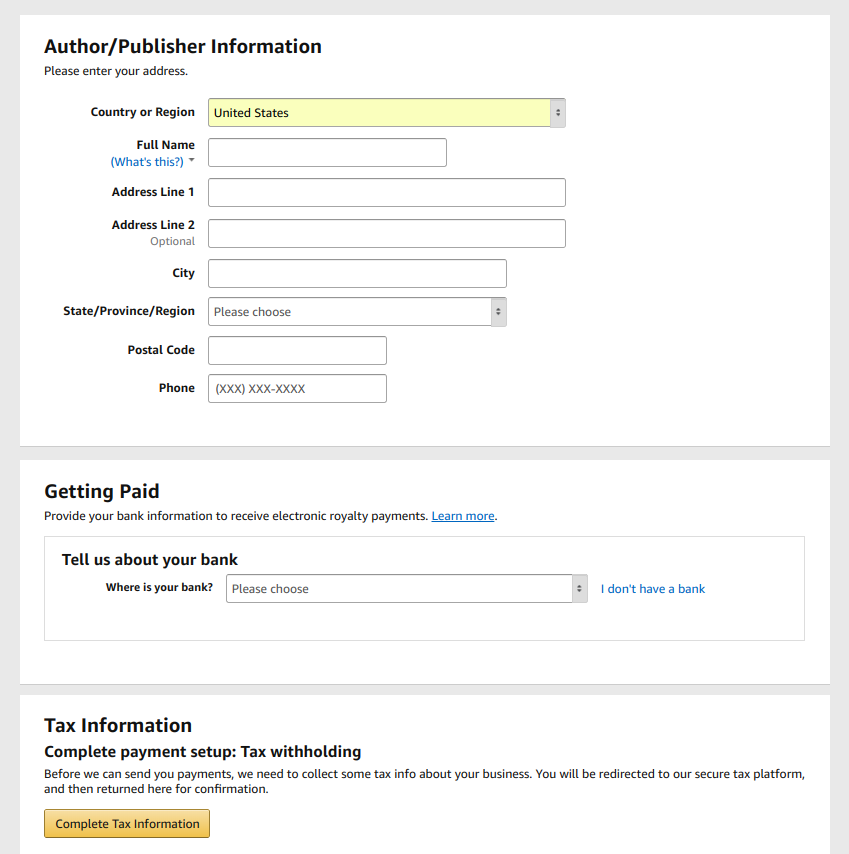
Your Amazon Kindle Direct Publishing account setup is free and takes just minutes to complete.
Once your Kindle Direct Publishing account setup is complete, you can log into your KDP dashboard, shown below.
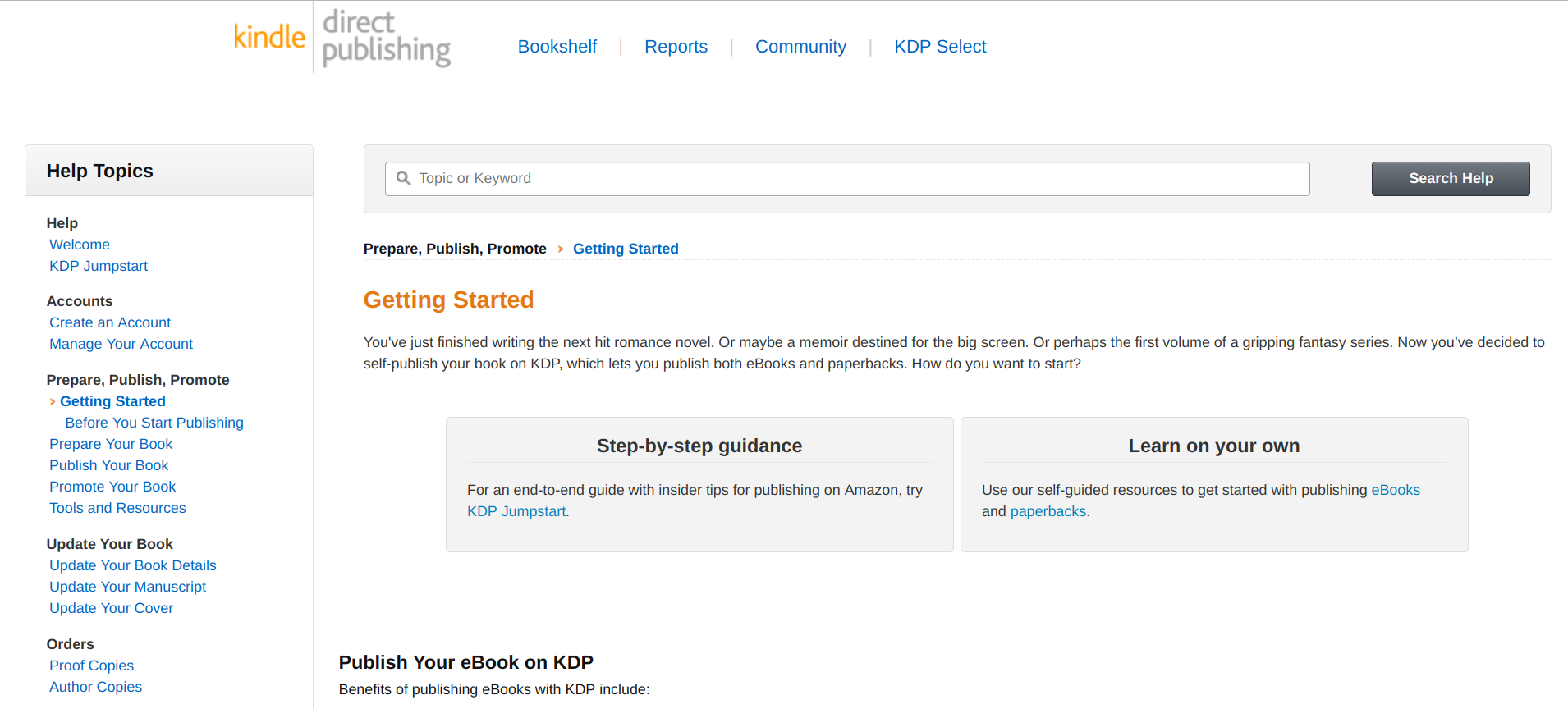
Visit the Amazon KDP help center to quickly learn the ins-and-outs of selling books on Amazon.
Your KDP dashboard is where you upload, price, manage, and track sales on all of your Amazon book titles. Plus, you’ll find a whole host of tools to help you create and publish e-books, as well as print-on-demand paperbacks and audiobooks, and then market them throughout the Amazon marketplace.
It’s a good idea to explore all of these tools and tutorials even before your book is ready to publish. You should also read through Amazon KDP’s content and quality guidelines to understand what Amazon KDP expects from authors in terms of writing quality.
2. Set Up Your Author Page in Amazon’s Author Central
After setting up your Amazon KDP account, it’s good to create your Author Page on Amazon’s Author Central, too. This is a page on Amazon that lists your titles all in one place, plus it gives you a spot to list your biography and connect with readers shopping for books on Amazon.
To create your Author Page, you need to join Author Central, but this takes just seconds to complete. Amazon pulls your information in from your account, so the entire process is fairly automated.

Once you confirm your author identity, Amazon will connect any books you’ve already published to your page, like my book below:
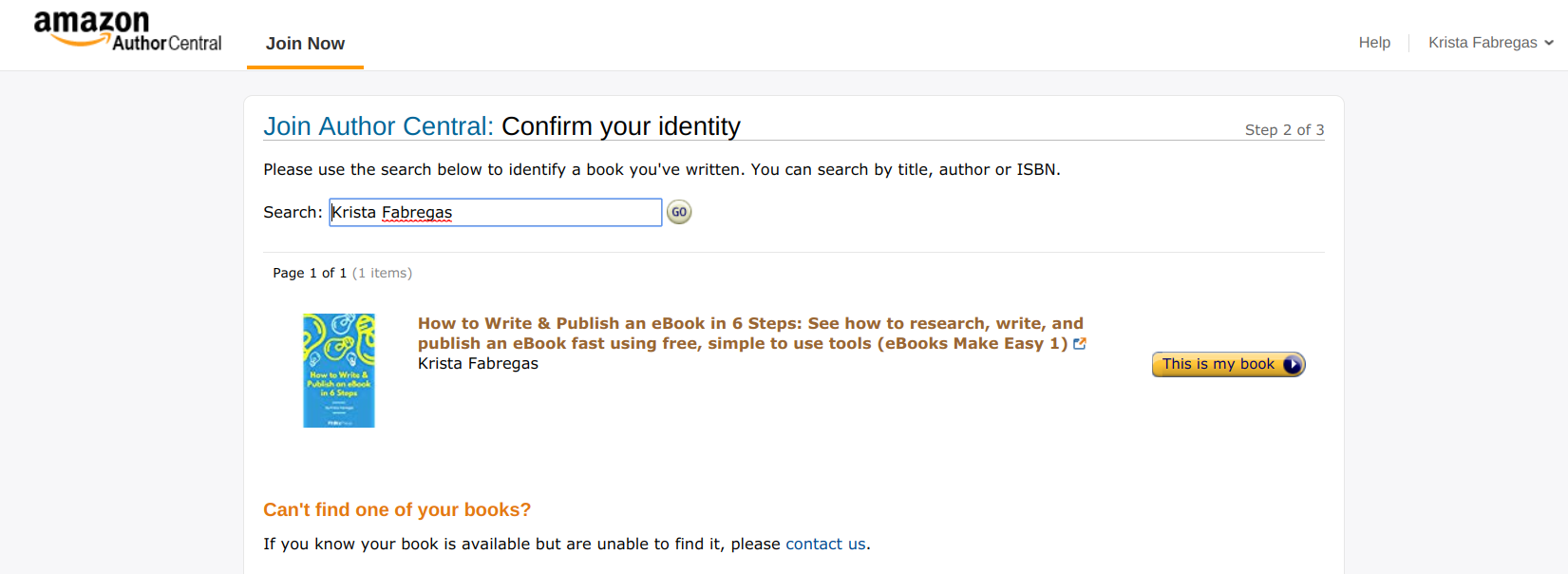
Once you’ve confirmed everything, Amazon will email you a link to your Author Page setup screen, where you can add your head shot, bio, blog posts, and even your speaker or appearance schedule if you have one. It can take Amazon a few days to make your Author Page live, so it’s a good idea to set it up when you create your KDP account so it’s ready when you are.
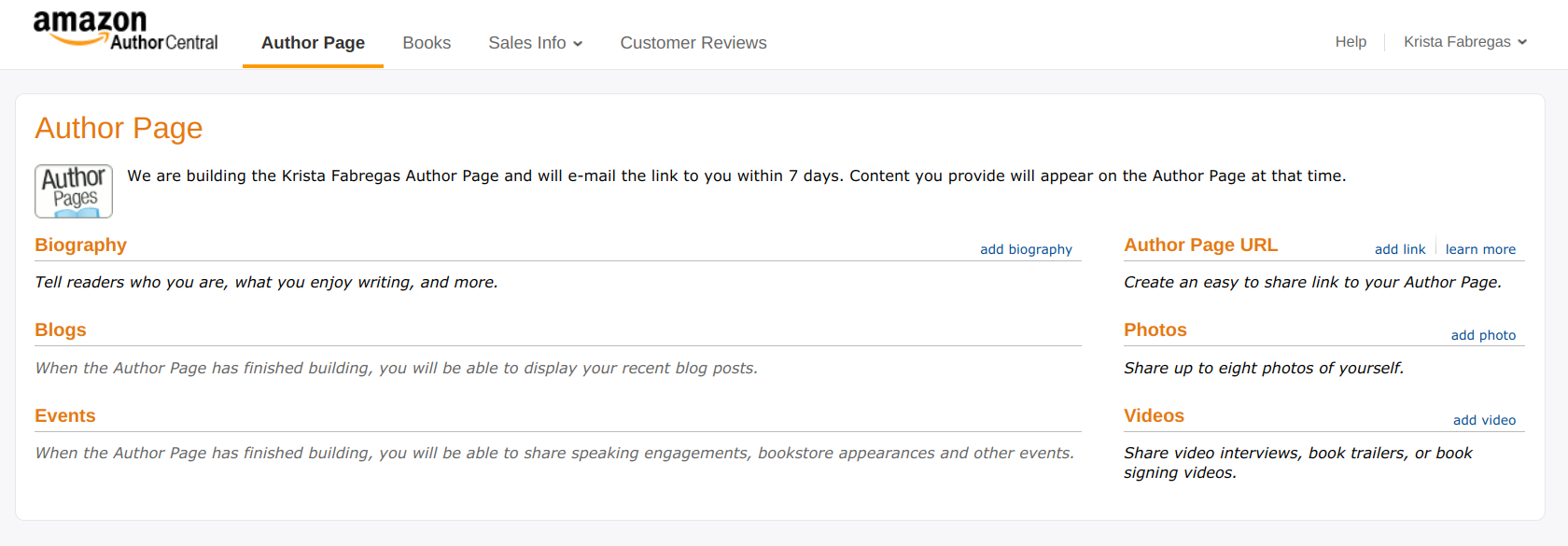
Your Amazon Author Page is hosted on Amazon and once set up, it lists all of your titles in one place.
Joanna Penn, a successful author who publishes both fiction and nonfiction works in Kindle and print books, makes great use of her Amazon Author page as a marketing tool. It features her titles for sale on Amazon, plus video and a blog post to help her readers learn more.
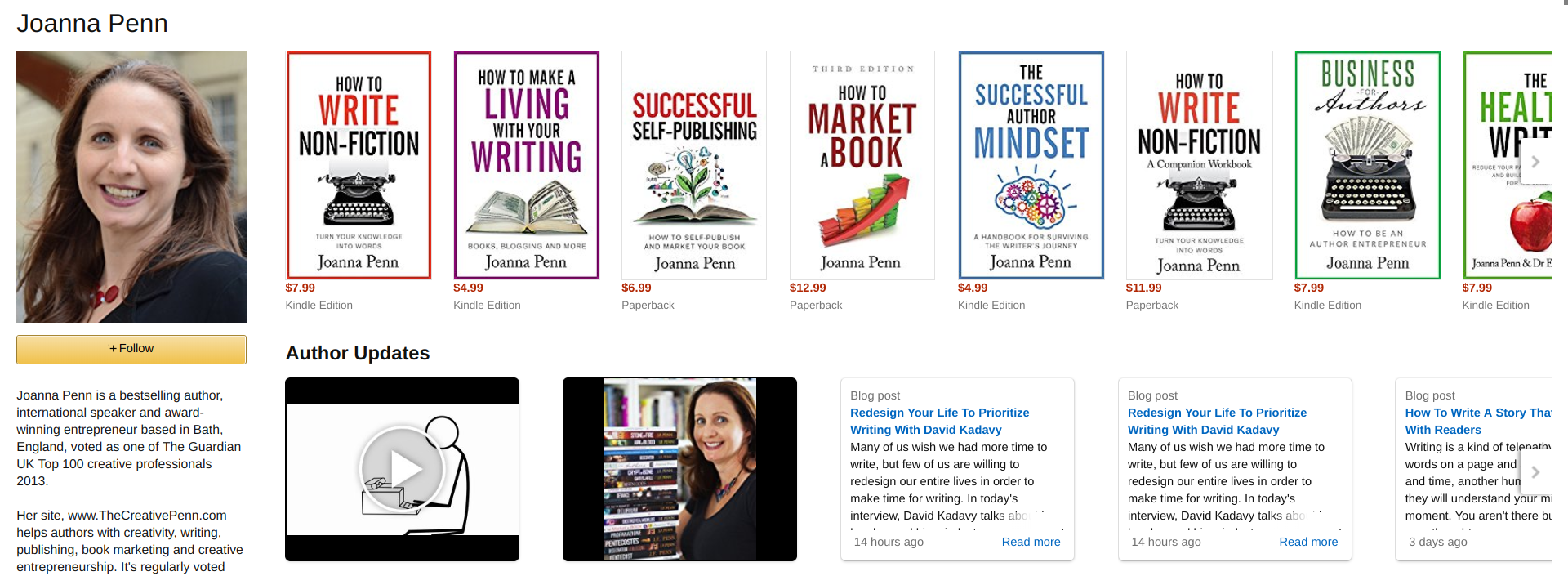
Joanna Penn uses her Amazon Author Page as a hub for her books, plus exposure for her blog posts from her WordPress website.
3. Create Your Book Listing on Amazon KDP
With your Kindle Direct Publishing account setup complete, you’re free to concentrate on completing your book. When your manuscript is written and edited and your cover art is ready, it’s time to upload your book to Amazon KDP and make it available in Amazon.
To do this, you’ll create a listing for your book within your Amazon KDP dashboard. Go to your Bookshelf and click on the type of book you want to publish—for most new KDP authors, that’s going to be a Kindle e-book. You can also publish print-on-demand paperbacks from this screen if you wish.
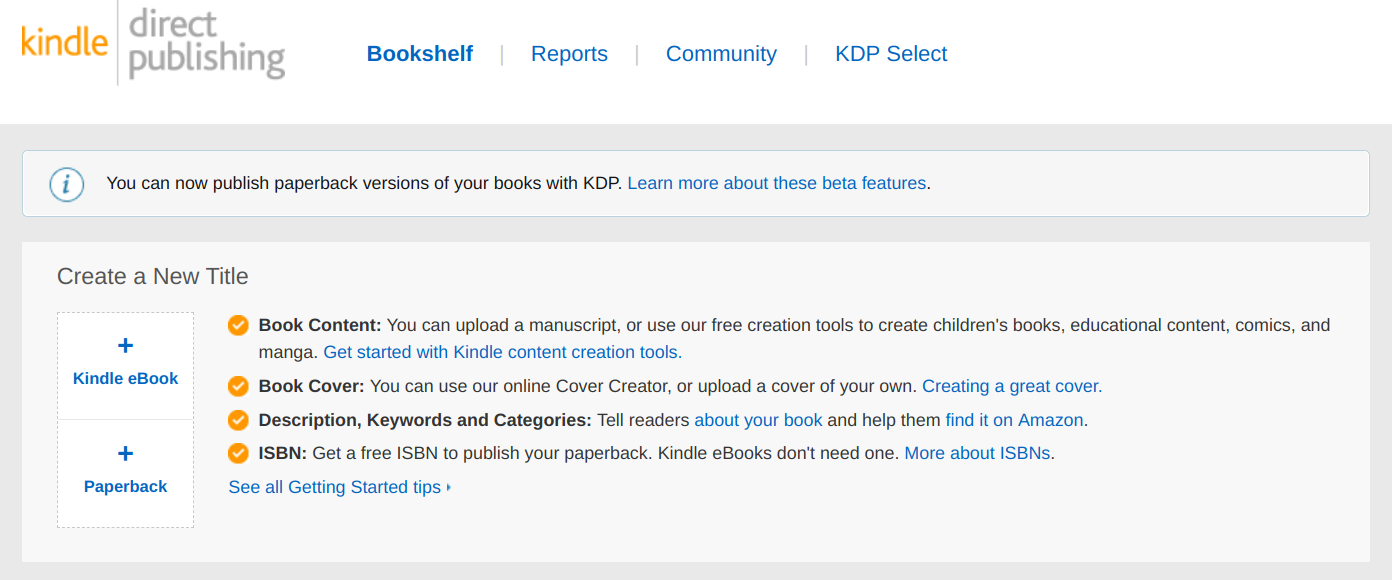
You can create a listing for an e-book or a paperback print-on-demand book, but you can also add a paperback option to your e-book listing now or later on.
KDP leads you through a three-screen process to set up your book details, upload your e-book content and cover files, and then set your pricing. It’s a very simple process, but it goes a lot faster if you have certain details ready beforehand, which we outline below.
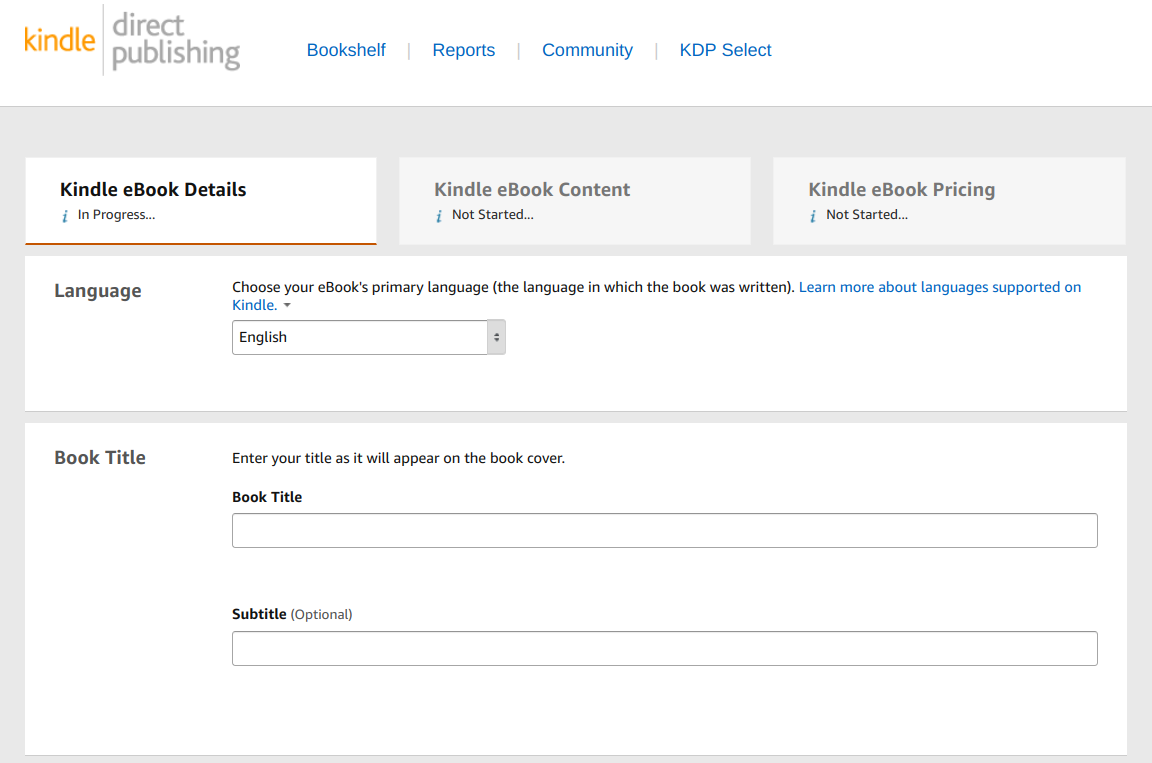
Creating a book listing in KDP is pretty quick if you have everything prepared ahead of time.
Screen 1: Book Details
The first screen is your Book Detail screen, and it’s the longest of the three. You can’t proceed to the next screen until the required fields are completed. To make this process quick, here’s what you need to prepare ahead of time:
- Book title and a short subtitle – Be sure to include your top keywords or phrases here.
- Selected categories for your book – You can list your title in two categories; learn about researching and selecting e-book categories in our e-book publishing guide.
- Keywords or key phrases – Help readers find your e-book in Amazon search by listing up to seven keywords or key phrases related to your title.
- Book description – Amazon gives you 4,000 characters to describe your e-book topic or story line. Be sure to make this enticing to encourage readers to want more, and include keywords naturally throughout.
- Series and edition numbers – If your book is part of a series or a new version, you can include that information.
- Contributors – If you have editors or collaborators, you can include their names in your book credits.
Screen 2: Kindle E-book Content
After entering your book details, you’re ready to upload your e-book file and cover art in the next screen. For this step, you’ll need:
- E-book file in a Kindle format – This is typically a Kindle-ready .mobi file or a .ePub file that KDP will automatically convert upon upload. Learn more in our guide to saving your e-book in a Kindle format.
- Cover artwork – Kindle Direct Publishing accepts cover art in a .jpg or .tiff file. The recommended image size in the KDP cover art guidelines is 2,560 px tall by 1,600 px wide. You can use KDP’s free cover creator, the free e-book templates on Canva, or hire a design pro on Fiverr to create an eye-catching cover for your book that meets the guidelines.
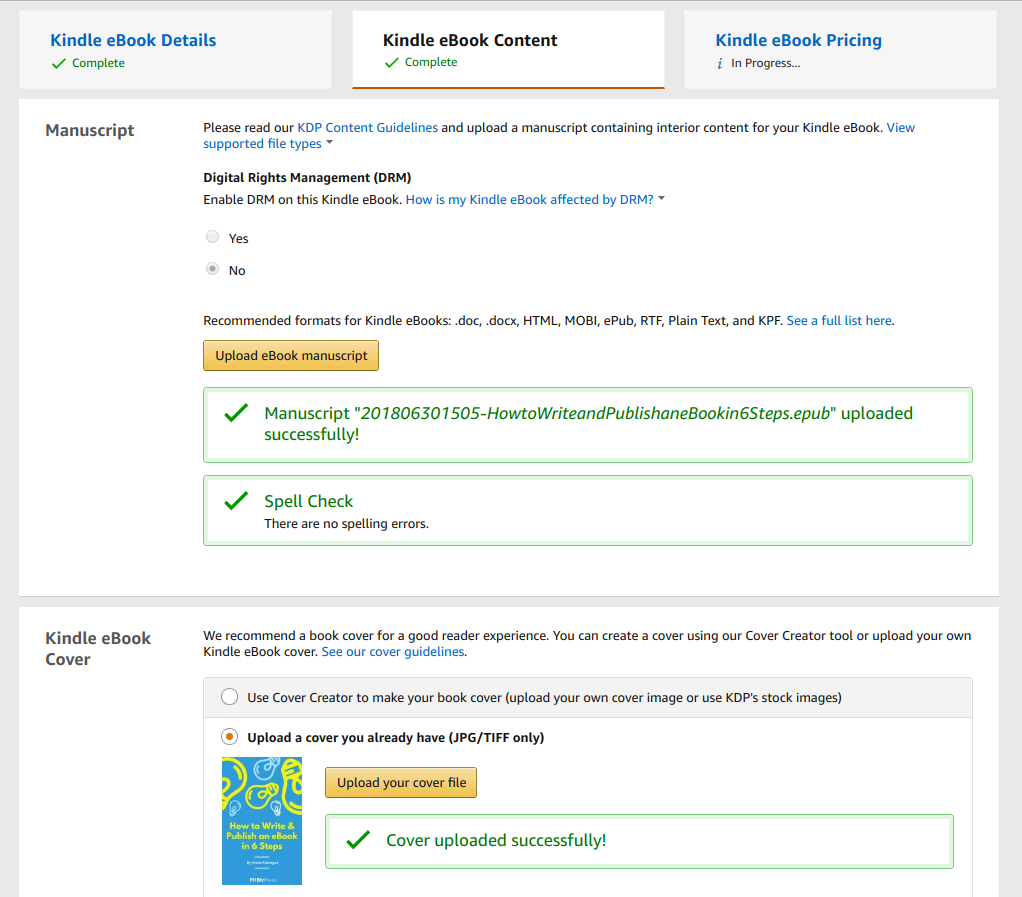
KDP’s e-book publishing process is a simple three-screen affair.
Note! At the bottom of this screen, you’ll see a field for an International Standard Book Number (ISBN). ISBNs aren’t required for e-books but are required for printed books. Amazon assigns an ISBN number for free if you publish a paperback book through Kindle Direct Publishing.
Once your e-book files are uploaded, KDP shows your files as imported successfully. If you follow our easy Kindle format guide, you shouldn’t have any problem with this step. Once uploaded, you can preview how your e-book will look on various Kindle devices in the built-in Kindle Previewer:
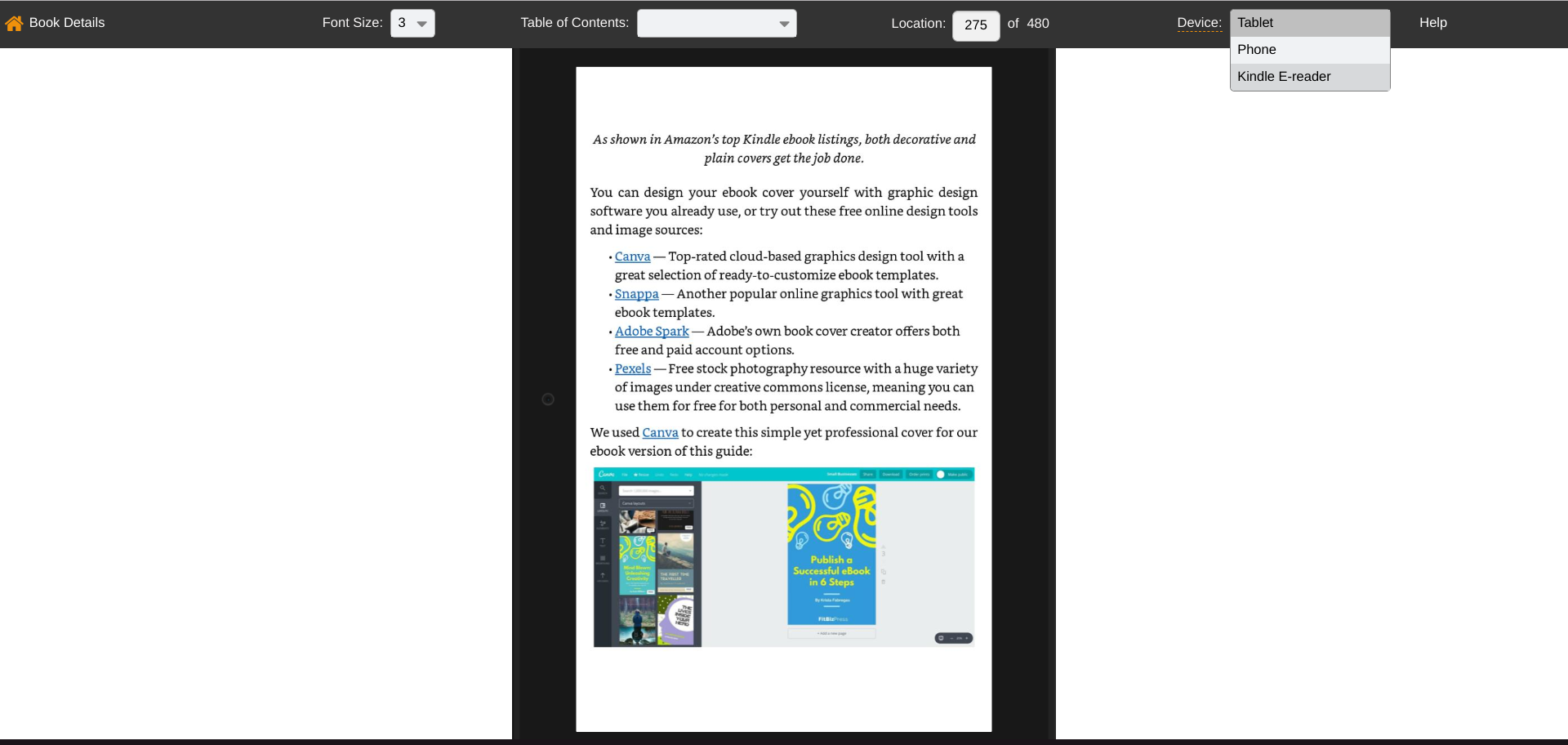
KDP’s online preview lets you test drive your new e-book in different Kindle screen sizes.
Once everything checks out in the Kindle previewer, you’re ready to move on to the last screen, where you’ll set up your pricing, finalize a few details, and launch your book for sale on Amazon.
Screen 3: Pricing
In the last screen, you’ll set your book’s price, your royalty preference, and the Amazon marketplaces where your book will be sold. In this screen, you can also enroll your title in the KDP Select program and take advantage of the benefits that come with Amazon exclusivity.
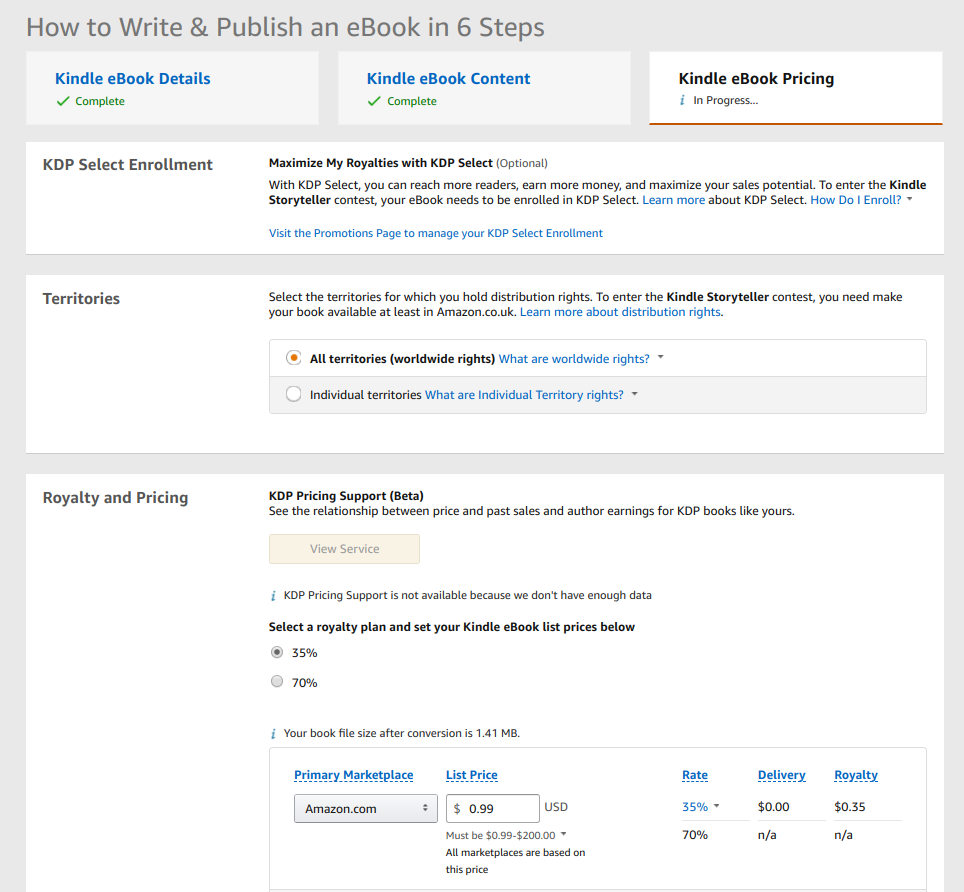
E-books priced at $2.99 and over qualify for a 70 percent royalty payout. E-book titles under $2.99 only receive a 35 percent royalty payout.
Unlike the previous screens, there’s not much to prepare for the Pricing Screen, but you do have some decisions to make. However, these decisions aren’t set in stone. You can decide to opt in or out of KDP Select at any time, change your pricing, and even select a different royalty percentage based on your pricing. Here are some things to keep in mind as you make these final choices:
KDP Select Benefits & Enrollment
KDP Select gives you access to many promotional tools to drive sales. Enrollment is per title and it runs on a 90-day cycle. While your book is in KDP Select, you cannot publish the same content in e-book or on a blog elsewhere. If you enroll your book in KDP Select and want to publish it elsewhere, you have to wait for the 90-day term to be up. If you want the title in KDP Select long-term, it will renew automatically.
In KDP Select, you can:
- Sell your book at the price you set
- Get paid for Kindle Unlimited (KU) and the Kindle Owners’ Lending Library (KOLL) reads
- Offer limited-time free book promotions
- Offer limited-time discounts in Kindle Countdown Deals
Titles not included in KDP Select can’t participate in any of these promotions.
Territory Selections
Most self-published authors who own full copyright to their content can publish anywhere, and Amazon makes that easy with automatic currency conversions. But if you’re publishing for an international business or as part of a collaboration, you need to make sure you have the rights and correct tax structure in place to publish in all or selected countries.
Pricing & Royalties
As a rule, Amazon allows you to price Kindle Direct Publishing e-books from $0.99 to $200. Amazon does not allow titles to be permanently listed for $0. Free pricing can only be applied to titles enrolled in KDP Select. Your pricing also impacts the royalty percentage you set—and thus, your profit potential. Titles priced at $2.99 or more are eligible for the 70 percent royalty. You can sell a book under $2.99, but under that price, your royalty is only 35 percent.
If your title is in KDP Select, which lists your e-book in Kindle Unlimited (KU) and the Kindle Owners’ Lending Library (KOLL), you also make money per-read and per-borrow. Here’s a closer look at how Amazon handles the payouts for these programs.
That wraps up the three main elements in this screen. There are a few other fields that you’ll check off, but these are very self-explanatory. After completion, you’re ready to click Publish Your Kindle E-book:

And that’s it. Congratulations! You’re now a published indie author. Your e-book listing will appear live in Amazon’s Kindle marketplace within 72 hours, and KDP will email you the notification when it’s live. Ours took about 45 minutes to become live and available for purchase:

It takes just minutes to become a published author once you create your listing and submit your Kindle format e-book file to Amazon KDP.
4. Market Your E-book on Amazon & Other Outlets
Okay, clicking the Publish button really isn’t it. In many ways, it’s just the start of your work, because now you need to market your book, both on Amazon and via other outlets. How you tackle this step largely depends on whether or not you chose to participate in Amazon KDP Select.
Below, we’ll explore your marketing options based on your KDP Select choice, then cover other ways you can market your e-book and attract readers.
If You’re Enrolling Your Title in Amazon KDP Select
According to Dave Chesson of Kindlepreneur, “Authors who enroll their titles in KDP Select tend to gain a larger audience faster due to the exposure to the massive Kindle Unlimited (KU) and Kindle Owners’ Lending Library (KOLL) reader base.”
As a KDP Select title, your e-book will appear in both of these lending listings, where you’re paid per-borrow and per-read, based on each program’s payout plan. You can have a title in KDP Select and not participate in these lending programs, but most new authors find them to be the fastest route to gaining reviews and a reader following.
But that’s not the only promotional benefit. “Writers who make a real success of the KDP Select program dig deep into every aspect, not just the KU and KOLL benefits,” says Chesson. Using limited-time free book promotions and Kindle Countdown Deals helps gain readers for new releases. These tactics also help bolster momentum for titles that have been published longer.”
So, if you enroll your title in KDP Select, these promotional benefits are the first ones to set up.
If You’re Not Enrolling Your Title in KDP Select
If you’re not in KDP Select, you can sell your book on other e-book marketplaces such as B&N Press (Barnes & Noble for NOOK readers), Kobo, and Apple iBooks. You can handle these listings yourself by creating your own account and profile, and uploading titles to each, much like you did with Amazon KDP. Or, you can use an e-book distribution service like Draft2Digital or Smashwords to distribute your e-book to these sites and many others. These distribution services take an additional fee on top of the royalties the other seller marketplaces pay, but the time saved generally is worthwhile.
As part of the exclusivity agreement, you cannot sell titles listed in Amazon’s KDP Select program on the other marketplaces. But if you don’t participate in KDP Select, this is a good way to market to more readers.
Other Amazon Marketing Tactics
Whether your title in KDP Select or not, you can use Amazon’s book advertising programs to attract readers from day one. This does have costs, but since these ad campaigns are keyword-driven, new and seasoned authors alike find Amazon ads effective in getting titles in front of readers interested in the topic of their e-book.
Amazon ads run under the pay-per-click (PPC) model. This means you’re only charged when a potential reader clicks on the ad and goes to your e-book’s listing page—which is half the battle in attracting readers. You can also set your budget and how much you’re willing to pay each time a potential reader clicks your ad.
There are two types of Amazon ads that you can try once your book is listed in Kindle Direct Publishing:
Sponsored Product Ads
These ads let you set the specific keyword yourself and appear at the top of Amazon’s search results as sponsored products. As shown below, these are the top two e-books appearing when we searched for “how to publish an e-book.” These top results say “sponsored” at the top, denoting that these are paid Sponsored Product Ads that use keywords that match our search term.
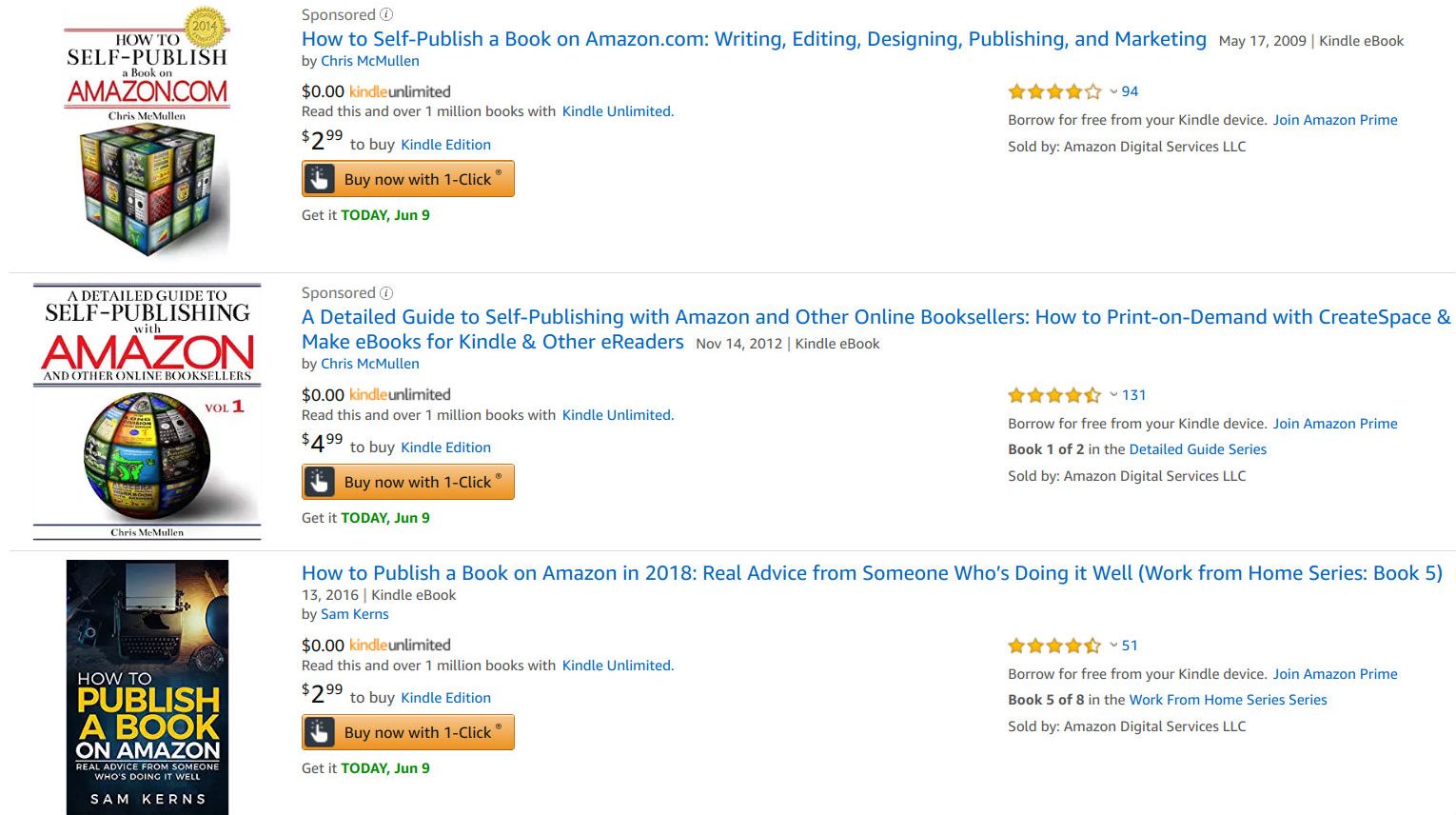
Amazon’s Sponsored Product Ads use keywords to appear in targeted search results.
Product Display Ads for E-books
These ads appear as related products on other e-book or product pages, like these e-books that appear on our e-book’s listing page, under our book information:
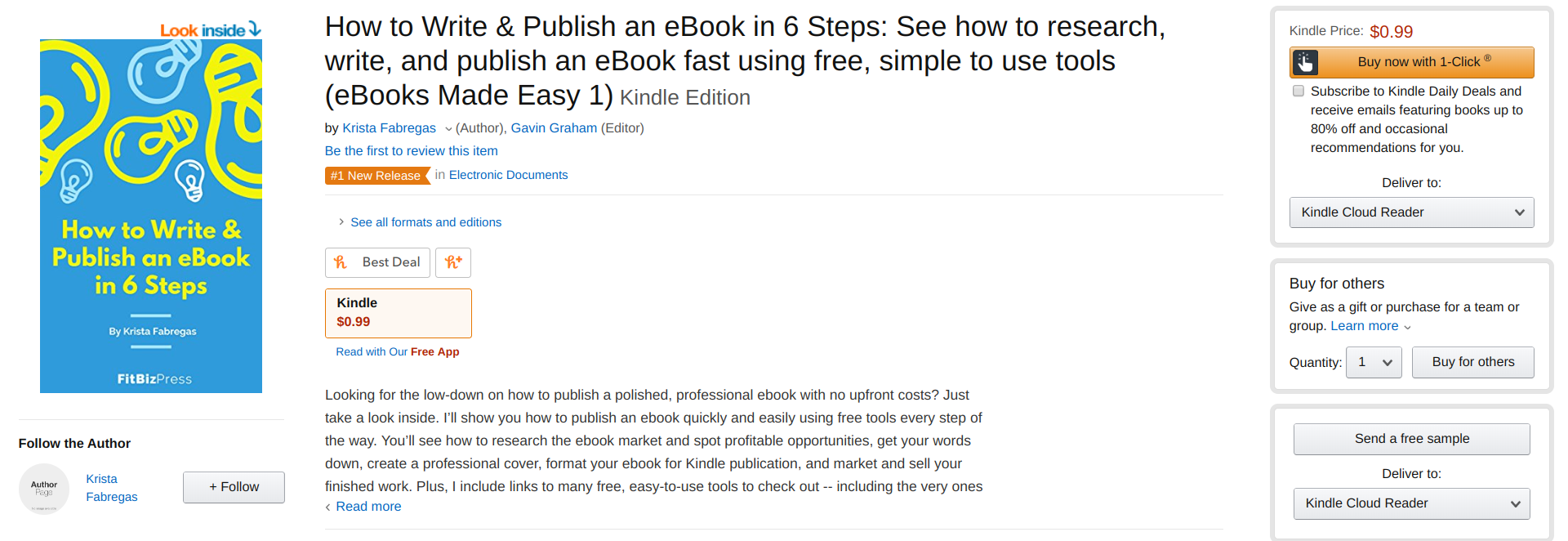
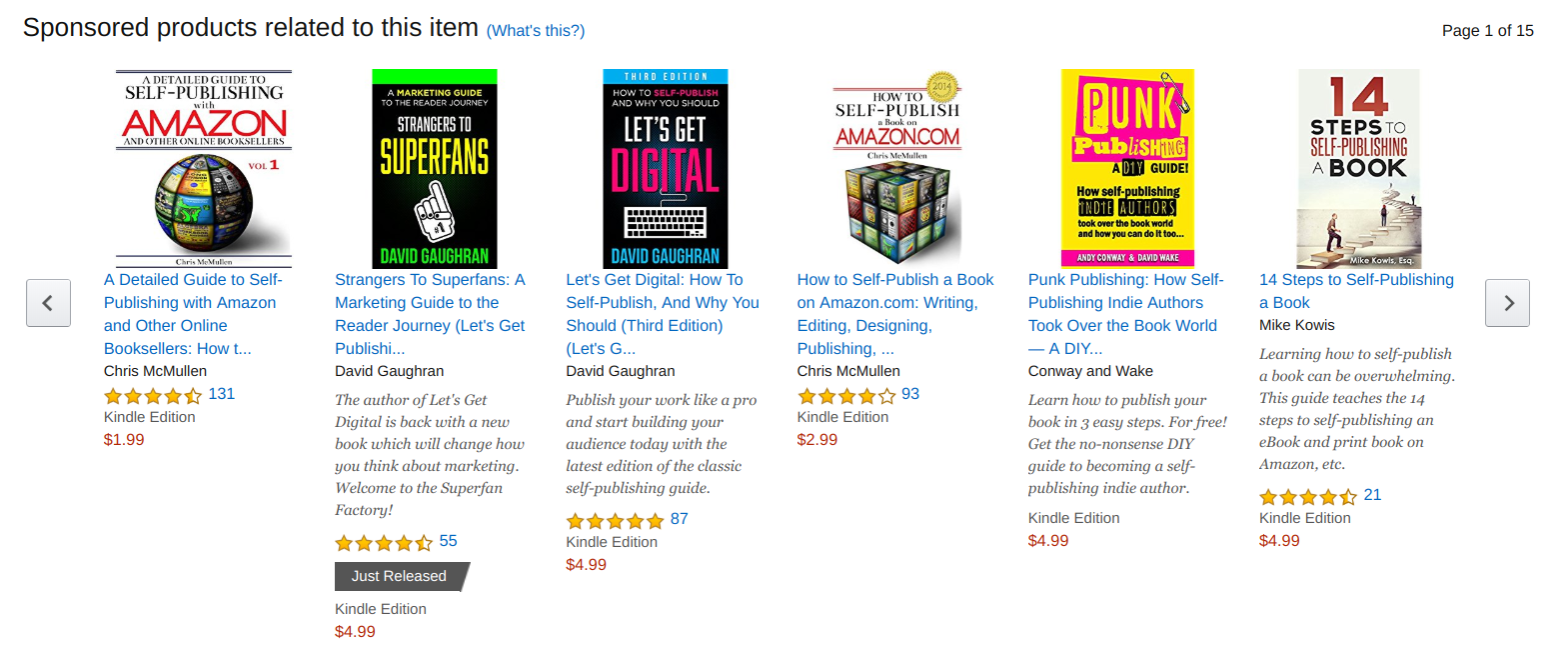
Amazon’s Product Display Ads appear as “related items” on other products’ Amazon listing page.
Ask for a Review
Reviews are a huge marketing tool for Amazon authors, but Amazon has very strict guidelines about reviews. You can’t trade a free copy for a review or offer any other type of compensation to build reviews—and you can’t ask for a “good” review. However, you can ask for a review, and the best way to do that is to include that request at the back of your e-book, like this:
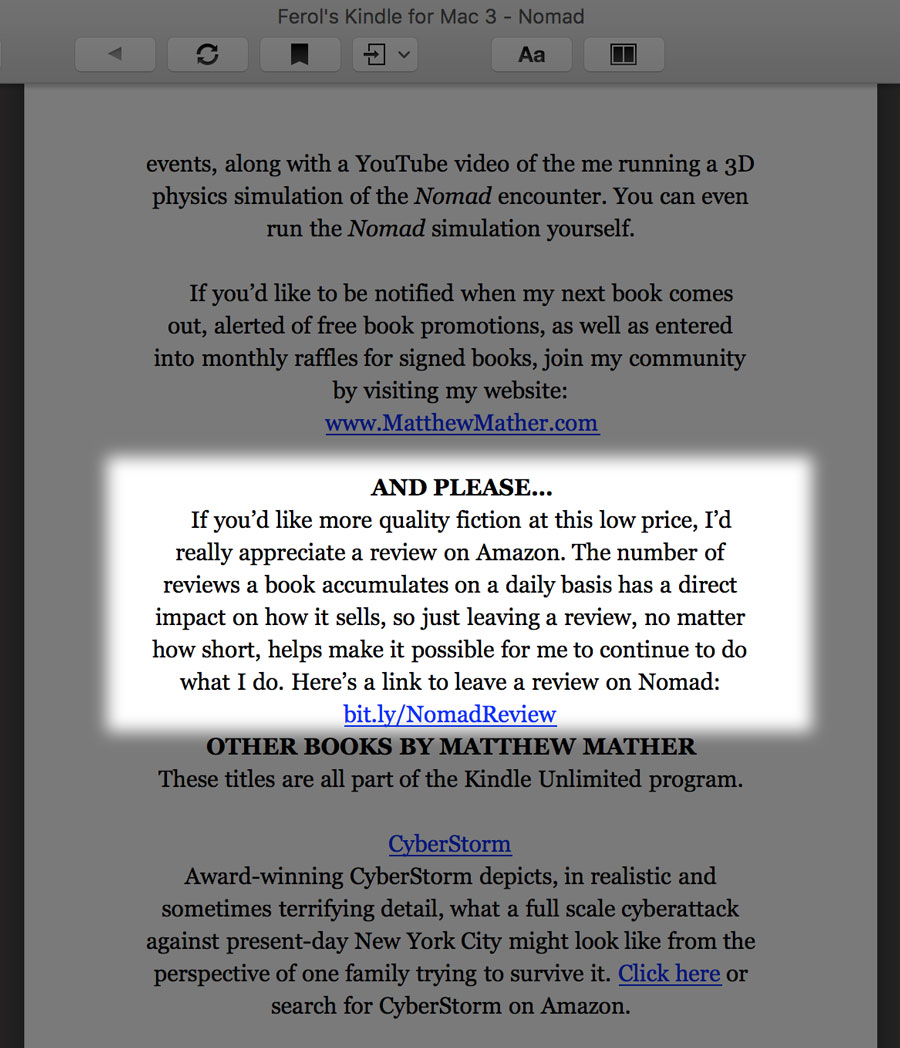
Matthew Mather, the author of “Nomad” and many other titles, asks for a review at the end of each book.
In your “back matter,” like the page above, you can thank your reader for reading your book and ask them to provide a review via a link. Kindles also automatically ask for this from readers who complete a portion of a book, so your readers will know what to do.
Marketing Your E-book Outside of Amazon
Beyond the borders of Amazon, and other e-book marketplaces if you go that route, there are many ways that you can—and should—market to potential readers and create a fan base for this and future works. Here is a rundown of the elements to consider.
Launch Your Own Website
According to best-selling novelist and nonfiction author Joanna Penn, “Your website is one of the most important things to get sorted if you’re serious about your author career.”

Joanna Penn manages multiple author websites to reach her fiction and nonfiction audiences.
Most successful authors view their e-books as marketable products, plain and simple. For them, a website is a primary marketing and branding tool.
“It’s how potential readers, along with agents, publishers, journalists, bloggers and podcasters, judge how professional you are,” says Penn. In fact, Penn credits much of her success to the reader base that her websites have managed to draw, along with the email lists that she’s built through these sites. “I’ve built a multi-six-figure business off the back of my author websites and email lists,” says Joanna Penn, author, coach, and founder of The Creative Penn
Penn and most other successful authors turn to WordPress to create a simple-to-manage website on a budget. You can start yours today on Bluehost for just $2.95 per month. We even have a quick-start WordPress tutorial that walks you through the setup process. Enter your name below to get started:
Send a Press Release
Press releases are an effective marketing tool for two types of authors: those who are releasing a new book in a series, and business professionals. For series authors, a press release targeting publications, reporters, and bloggers who follow your genre can help you spread the word about your latest installment. For business professionals, a press release targeting industry-related reporters and publications can garner coverage, reviews and commentary, and even land interview opportunities.
eReleases.com is an online press release service that lets you closely target release distribution to specific audiences. Plus, eReleases gives you the tools you need to create and set up distribution yourself, or you can tap seasoned pros to handle all of the details for you.
Build an Email List
With your website live, you can start building your email list to communicate with your readers. You can connect an email marketing service to gather addresses to market your current and upcoming titles to readers via email marketing. Use new releases, sneak-peek chapter reads, and first-to-know promotions to entice readers to join your list.
Use Your Social Media Channels
Create social media author pages on Facebook, Instagram, Pinterest, and Twitter, and share posts about your new releases, teasers about works-in-progress, free promo announcements, and other creative attention-getters to connect with your fans and build a following.
Participate in Book Clubs and Reader Collectives
Local and online book clubs and reading collectives are another way to attract new readers and receive reader feedback. GoodReads (part of Amazon), Reedsy Discovery, and LibraryThing have genre-specific reader communities that you can use to publicize your e-books and build a readership. Depending on your use of KDP Select, you can offer free reads or giveaways, or simply announce any free KDP Select promotions to gain attention from new readers.
Mistakes to Avoid When Selling Books on Amazon KDP
The biggest mistake to avoid when trying to sell books on Kindle Direct Publishing is to expect instant results. Selling an e-book is just like selling and marketing any other product. It takes work, time, and effort across multiple marketing outlets, and commitment. Most authors only see some return after publishing several works and marketing each one, which is what it takes to build up a reader base.
The second major mistake that new writers must avoid is publishing an amateurish work to Kindle Direct Publishing. Poorly written books that are badly edited and full of errors are a major turn-off to readers, and messy covers will never help sell your work. Plus, both mistakes go against Amazon’s quality guidelines. So, don’t be in a hurry to publish. Take the time to edit your work and create a great cover—or better yet, get a pro involved.
You can find budget-friendly freelance editors and cover designers who specialize in e-books on Fiverr. These seasoned experts are familiar with Amazon’s quality guidelines and will give your work the professional polish it deserves.
The Bottom Line
Learning how to sell books on Amazon Kindle Direct Publishing is simple and complicated at the same time. Once your book is written and saved as a Kindle format, signing up for Amazon KDP and listing your book to sell on Amazon is simple—you really have just a few bits of information to enter and decisions to make.
Once your book listing is live on Amazon is when the real work begins—marketing your title and author brand. Amazon gives you many tools for this: a free Author Page, KDP Select’s many promotional opportunities, and paid ads. You can also market your work beyond Amazon’s borders via other e-book marketplaces, press releases, online book clubs and collaboratives, and your own website, email, and social media outlets.
Are you working on an e-book to publish on Amazon or do you already have some titles listed? We’d love to hear about the e-book creation platforms and marketing tools you use to get the job done in the comments below.
 “Writers or business professionals with a business entity with its own tax number and bank account can sell books on
“Writers or business professionals with a business entity with its own tax number and bank account can sell books on 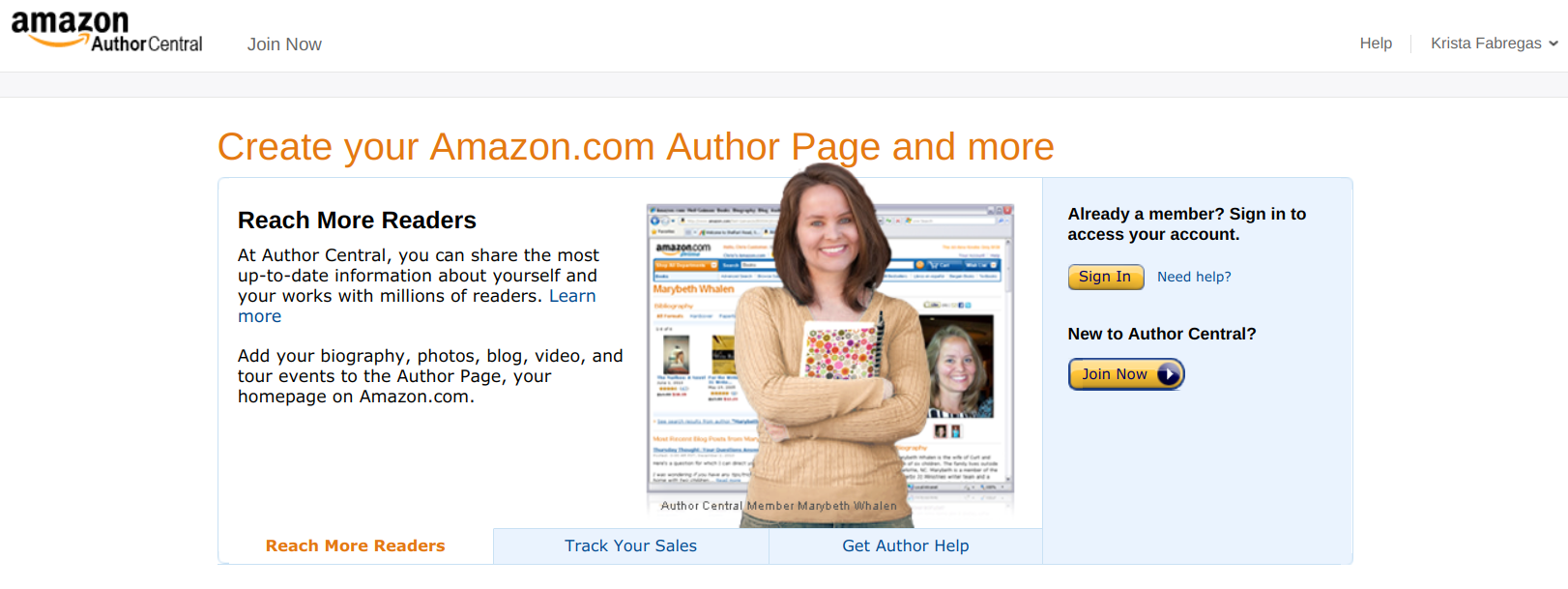
 “It’s how potential readers, along with agents, publishers, journalists, bloggers and podcasters, judge how professional you are,” says Penn. In fact, Penn credits much of her success to the reader base that her websites have managed to draw, along with the email lists that she’s built through these sites. “I’ve built a multi-six-figure business off the back of my author websites and email lists,” says Joanna Penn, author, coach, and founder of The Creative Penn
“It’s how potential readers, along with agents, publishers, journalists, bloggers and podcasters, judge how professional you are,” says Penn. In fact, Penn credits much of her success to the reader base that her websites have managed to draw, along with the email lists that she’s built through these sites. “I’ve built a multi-six-figure business off the back of my author websites and email lists,” says Joanna Penn, author, coach, and founder of The Creative Penn